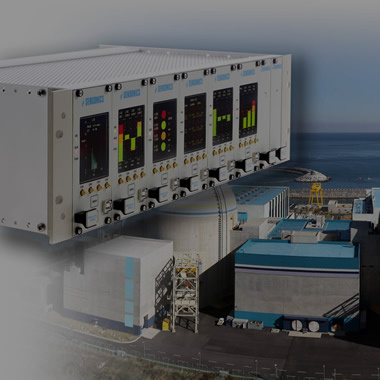Incorporating Vibration Monitoring Into Your System Design
Vibration monitoring systems provide a wide range of benefits. From increased operator safety, to more efficient maintenance procedures, early warning for impending problems,
extended operating life and improved productivity, vibration and displacement sensors and monitoring equipment play an essential role in safeguarding assets. Most vibration monitoring systems are designed to be generic and therefore suitable to be retrofitted to a large range of rotating plant, although typically OEMs incorporate bespoke sensors and interfaces into the component design phase. This saves time and money, and allows precision systems to be designed to accurately monitor the condition of rotating machinery – and rapidly feedback diagnostic information.
VIBRATION MONITORING SYSTEMS | PRACTICAL GUIDE FOR ENGINEERS
Vibration monitoring systems comprise sensors and monitoring equipment – both of which must be carefully selected and integrated to match the performance parameters of
the application. This guide is therefore divided into three parts.
In part one, we discuss the various types of sensor and how they are used, before moving on to monitoring equipment in part two. With these considerations in mind, part three
addresses questions an engineer should ask when designing an integrated vibration monitoring system for their application.
Sensors
There are three main types of machine-mounted vibration sensor, each designed to record a specific type of motion as processed by the monitoring system. These measurements are acceleration, velocity and displacement/proximity. The three types of measurement are all mathematically related, and, of course, vibration in a specific context may manifest as changes in more than one measurement.
Nevertheless, selecting the most appropriate type of sensor for your application, and installing it properly, is critical to accurate performance and reliable results. Your choice may also be affected by ongoing maintenance requirements for your monitoring system, spare parts availability, and the ISO standards for the different measurements.
Types Of Vibration Sensor
1. Accelerometers (g or m/s²)
Accelerometers measure absolute acceleration, and are the most commonly used type of motion and vibration sensor. They can be adapted to a wide range of applications and
system designs, and are available for various frequency and amplitude ranges – from DC to over 20kHz. Although the broadband nature of the device is a strength, a common
drawback of accelerometer applications is their susceptibility to high-frequency vibrations outside the frequency band of interest – and the consequent risk of amplifier overload and
saturation.
2. Velocity Sensors (mm/s or inches/s)
Velocity sensors measure cyclic vibrations and relative changes in the velocity of moving components in a rotating system. They are more sensitive to low-frequency vibrations,
making them useful for monitoring balance within rotating machinery, and as an early warning system for impending mechanical faults. Velocity sensors are available using
either piezoelectric or a magnet & moving coil arrangement. The later depends on induced electromagnetic currents to generate a velocity signal through a coil and magnet
interaction. Most modern systems utilise solid state piezoelectric sensors with internal vibration amplifiers, which provide accurate velocity readings under a wide range of
operating conditions and temperatures. However, the electrodynamics sensor has its advantages in being less susceptible to resonances, providing a higher sensitivity and
being less susceptible to noise in heavy industrial environments.
3. Proximity Probe / Displacement Sensors (mil or microns)
Displacement vibration monitoring utilize non-contact proximity sensors, or eddy current probes, which are used to detect the peak to peak vibration of a rotating shaft, relative to
the bearings and support structures. Displacement is measured in either mil or microns of movement from the target surface.
Monitoring Equipment
To use a rough analogy, if sensors are the eyes and ears of your vibration monitoring system, the monitoring equipment is the brain. Having the right monitoring equipment in
place is vital for your system to accurately process, analyse, and act on the data coming in from the sensors. There are four main considerations when designing a monitoring array,
which we will address in turn below – inputs & outputs, mechanical arrangement, measurement modes, and compliance.
1. Inputs And Outputs
The monitor must suit the sensor and be able to process the sensor signal. There are many types of sensor interfaces and the monitor must be able to power the sensor, accept the
signal and detect a sensor fault. Flexibility in the monitor is important to address a wide range of sensors and measurement applications. What outputs are required? 4-20mA,
Alarm relays and digital communications. All these outputs need to fit with the client system to provide effective reporting of vibration levels and alarms.
2. Mechanical Arrangement
For large multichannel requirements, rack-based systems are preferred mounted in cabinets. These are typically 19” standard with various modules for plugging in to the racks
to suit the requirement. Most rack-based modules are either 2 or 4 channel – with the latter offering higher density. For smaller applications and integration into existing equipment
panels, DIN Rail mount formats should be considered. These are compact and easy to install. The monitors tend to be 2-channel but offer good flexibility in terms of integration.
3. Measurement Modes
The signal processing of the sensor output should be selected to suit the measurement application. Various machines have different vibration signatures and extracting this
signature in the signal processing is key. Therefore, systems which offer flexible filter ranges and different analysis methods of the vibration waveform can future-proof the installation.
4. Compliance To Standards
Many applications call for compliance to various standards. The most common specific to vibration is the API 670 standard for Machinery Protection Systems. This standard has been
developed through many years of practical experience and equipment with stated compliance provides best practice in terms of vibration monitoring. Of course, the application will also have various environmental, seismic and EMC requirements which should be verified against the selected system.
With more than 40 years’ experience developing vibration monitoring, condition monitoring and measurement instruments for businesses working in the most demanding
environments, our product range and consultative service is second to none. We are the UK’s leading experts in vibration monitoring solutions, with a highly qualified team ready to advise you on all aspects of design, installation, product selection, and commissioning.
We take a unique approach to machine monitoring. Our aim is to minimise the variation of measurement hardware you need for each machine, with a single monitoring system to
carry out a range diverse functions – a compact solution requiring a minimal spares holding. Each system is designed with inbuilt flexibility to interface with a wide range of industrial
sensors, and to guarantee compatibility with all leading brands.
Questions To Ask When Designing Or Specifying A Vibration Monitoring System(Opens in a new browser tab)
Article Source From Sonsonics.


